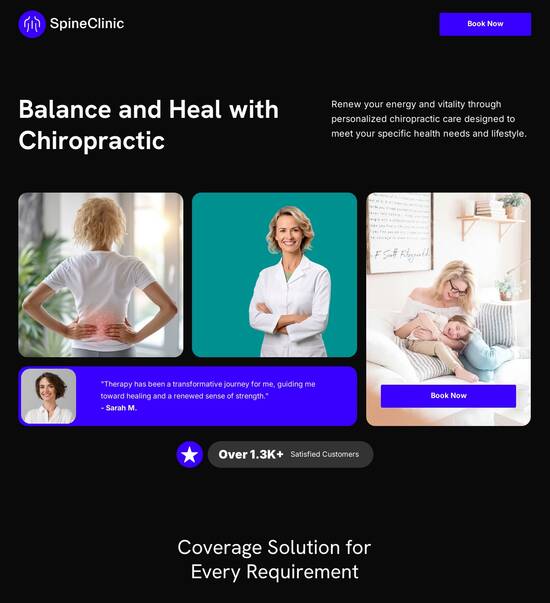
Gray one page website template
Explore Similar TemplatesAbout template
Transform your vision into reality using a customizable gray one page website template.
Recommended templates

Easy to build without coding
With the intuitive drag-and-drop builder, anyone on your team can create high-converting pages without any knowledge of code or design. Make enhancements to your landing page with custom widgets using Javascript, HTML/CSS, or third-party scripts.

Multiple layouts for any industry and goal
Select from 500+ landing page layouts built to boost conversions across industry-specific scenarios. Customize them by adjusting fonts, adding images, and generating on-brand content with the AI assistant. Quickly scale with Instablocks® and Global Blocks that you can save, reuse, and update globally.

Loads fast and looks polished on any device
Every template is responsive, which means they present professionally on any device and load blazingly fast with our Thor Render Engine. You can also power them up with Google AMP technology to deliver an unparalleled mobile experience and drive higher conversions.

Robust analytics & experimentation
Get real-time updates and reporting across all your devices, showing the number of visitors, conversions, cost-per-visitor, and cost-per-lead. Launch AI-powered experiments, run A/B tests, and use heatmaps to analyze user behavior, then optimize your landing page to maximize conversions.







Easy to build without coding
With the intuitive drag-and-drop builder, anyone on your team can create high-converting pages without any knowledge of code or design. Make enhancements to your landing page with custom widgets using Javascript, HTML/CSS, or third-party scripts.
Multiple layouts for any industry and goal
Select from 500+ landing page layouts built to boost conversions across industry-specific scenarios. Customize them by adjusting fonts, adding images, and generating on-brand content with the AI assistant. Quickly scale with Instablocks® and Global Blocks that you can save, reuse, and update globally.
Loads fast and looks polished on any device
Every template is responsive, which means they present professionally on any device and load blazingly fast with our Thor Render Engine.
Robust analytics & experimentation
Get real-time updates and reporting across all your devices, showing the number of visitors, conversions, cost-per-visitor, and cost-per-lead. Launch AI-powered experiments, run A/B tests, and use heatmaps to analyze user behavior, then optimize your landing page to maximize conversions.
All the features you need to build lead-generating landing pages
Explore more featuresLearn how to build top-performing landing pages for any goal
FAQs
Leading the way in building high-performing landing pages





A comprehensive guide to creating effective landing pages with Instapage
Landing pages are crucial for maximizing conversions, especially for marketing professionals across various sectors such as business services, tech, and education. Instapage offers marketers a powerful platform to design, optimize, and scale their landing pages, ensuring that every campaign is successful and ROI is maximized. This guide will walk you through the essential steps of using Instapage to create high-converting landing pages.
Understanding the key features of Instapage
Instapage is packed with features designed to meet the needs of marketers in various industries. These include over 100 high-converting templates, advanced optimization tools, and robust collaboration capabilities. Cozy up to features like dynamic text replacement and heatmaps that help understand user behavior on your landing pages.
- High-converting templates: Choose from over 100 customizable templates designed for various marketing needs, ensuring quicker deployment and effectiveness.
- A/B testing: Experiment with different versions of your landing page to find the most effective elements and layouts.
- Analytics dashboard: Track performance metrics to gauge the success of your campaigns and make data-driven decisions.
Step 1: Choosing the right template
Starting with the right template is vital to establishing your landing page's success. Instapage’s library offers templates tailored to various industries, ensuring that each option resonates with your target audience.
- Identify your campaign goal: Select a template that aligns with your objectives, whether it’s lead generation, sales, or ongoing marketing.
- Consider your audience: Choose designs and copy that appeal specifically to the demographics you're targeting.
- Keep mobile optimization in mind: Ensure your template is mobile-responsive to capture leads on mobile devices.
Step 2: Engaging your audience with content
Now that you have your template, the next step is crafting engaging content that drives conversions. Your content must be tailored to speak directly to the needs and pain points of your audience.
- Clear call-to-action (CTA): Use strong, actionable language to guide your audience’s next steps.
- Address pain points: Offer solutions to the common challenges your audience faces.
- Use visuals: Images and videos can significantly enhance engagement and convey your message more effectively.
Step 3: Optimize and test your landing page
Once your landing page is designed and populated with content, the crucial phase of optimization begins. Utilize Instapage’s built-in tools to ensure your page is performing at its best.
- Utilize heatmaps: Analyze user behavior to see where visitors are clicking most frequently.
- A/B testing: Conduct experiments to assess different layouts and content versions, iterating until you reach optimal performance.
- Monitor performance metrics: Keep an eye on key indicators such as conversion rates and bounce rates through your analytics dashboard.
By following these steps, marketers can leverage Instapage's powerful features to create effective landing pages that drive results and ensure successful campaigns.
Ready to enhance your landing page strategy? Sign up for Instapage today and take the first step toward transforming your digital marketing efforts!
People also ask about Gray one page website template
The gray one page website template: A guide to effective online presence
The evolution of the gray one page website template
The gray one page website template has navigated its way through various design trends and technological advances. The simplicity and elegance that gray offers, combined with the streamlined functionality of a one-page layout, make it an attractive option for businesses across multiple sectors. More marketers and web designers are realizing the power of clear, focused messaging in a concise format, particularly in an era where user attention spans are shorter than ever.
Unpacking the essentials of a one page website template
A one page website template is a streamlined design format where all critical information resides on a single page, thereby eliminating the need for multiple links and clicks. The primary goal is to facilitate a user experience that is both intuitive and efficient, guiding visitors seamlessly through a narrative from introduction to conclusion. It caters well to businesses wanting to present their services succinctly, allowing users to absorb the information quickly and act accordingly.
Distinguished from multi-page variants, one-page templates consolidate everything into a scrollable layout. Ideal use cases include portfolios, event promotions, and product launches where designers aim to produce a single, cohesive story. The essential components of a one-page template often comprise a header that includes a logo and navigation links, divided content sections, and a footer that may incorporate contact information and social media links.
Header: Contains vital branding elements like the logo and navigation.
Content Sections: Each section serves a purpose, such as showcasing services, testimonials or portfolios.
Footer: Provides essential details such as contact information and links to social media.
The focus on storytelling in single-page design is crucial. Every section should seamlessly lead to the next, creating a narrative that becomes engaging and informative, ultimately enhancing user retention. This cohesive approach is what transforms a simple webpage into a compelling experience.
The allure of gray: Aesthetic and design significance
Color psychology significantly influences user perceptions during their online interactions. Gray is renowned for its neutrality, and as such, it demonstrates a balanced approach that speaks to modernity and professionalism. The psychological understanding of color suggests that gray cultivates an environment that enhances readability, making textual content easier to grasp while simultaneously portraying brand reliability.
Furthermore, gray serves as an excellent backdrop to incorporate accent colors, allowing brands to infuse personality without overwhelming visitors. For instance, a tech company may opt for bright blues or greens to juxtapose against a gray template, ensuring that key messages stand out. The seamless combination of gray with textures like gradients or subtle patterns can add depth without compromising clarity.
Psychological effects: Gray evokes calmness and professionalism.
Color combinations: Gray pairs well with a myriad of accent colors.
Textures: Background patterns can enhance the site's visual interest.
Several case studies illustrate the effectiveness of gray templates across diverse sectors. For example, a creative agency may showcase their portfolio on a minimalist gray backdrop, highlighting the vibrancy of their work. In contrast, a corporate entity might utilize gray to imbue trust and reliability while communicating directly with their audience.
Tailoring your needs: Why choose a gray template
As online design preferences shift toward minimalism and clarity, the gray one page website template finds itself at the forefront of these trends. An uncluttered design philosophy aligns well with user preferences, contributing to enhanced user experience and retention. The straightforward presentation minimizes distractions allowing visitors to focus solely on content.
Understanding the target audience is paramount when selecting a gray template. Market trends indicate that many users prefer designs that prioritize easy navigation and simplicity. This is especially relevant in tech, marketing, and education sectors, where information overload can deter engagement. For services aimed at millennials and Gen Z users, gray templates can create a sense of sophistication and relatability.
Market trends: Increased preference for minimalist designs.
User preference: Gray appeals to those seeking clarity.
Industry adaptation: Highly effective across various sectors.
In sectors such as tech and creative industries, gray templates often resonate well with audiences seeking innovative solutions and artistic expressions. The color gray can convey a sense of refinement, serving to foster trust with potential clients and customers alike.
Seamless setup: Deploying your gray one page template
Once you've chosen your ideal gray one page website template, the next step is the setup, which requires a clear understanding of prerequisites. Checking for hosting compatibility, choosing the appropriate content management system (CMS), and ensuring you have the necessary assets at hand is essential for a smooth deployment process.
Typically, installation processes can vary based on the platform you opt to use, be it WordPress or other CMS solutions. In general, the setup would involve uploading the template file, activating it, and customizing it according to your brand aesthetic. This could include tweaking color schemes, images, and fonts while retaining the template's innate design integrity.
Pre-requisites: Verify hosting and CMS compatibility.
Walkthrough installation: Steps vary based on platform.
Customization: Edit color schemes and dedicated design elements.
Best practices for customization include using consistent colors, ensuring typography is legible across devices, and maintaining brand consistency. Clarity and ease of navigation remain top priorities, facilitating user engagement and improving conversions.
Hosting considerations for optimal performance
Selecting the right hosting plan is vital for your gray one page website template to ensure optimal performance. Given that these templates rely heavily on swift loading times and reliability, evaluating hosting providers based on uptime and speed is important. Shared hosting is often cost-effective but may not provide consistent performance. In contrast, virtual private servers (VPS) offer dedicated resources to ensure that your gray template runs smoothly.
When weighing the cost versus benefits, the implications of hosting types become clear. For smaller businesses, shared hosting may suffice, but as traffic grows, transitioning to VPS or dedicated hosting may become necessary to maintain optimal site performance. Thus, carefully evaluating your needs and potential growth can save future headaches.
Hosting plans: Assess uptime and speed requirements.
Shared vs. VPS: Weigh pros and cons based on expected traffic.
Cost vs. benefit: Align hosting choices with business needs.
Optimizing for search engines and performance includes ensuring that your hosting plan allows for sufficient bandwidth and has features like caching to improve load times. This attention to detail translates into a better user experience, ultimately boosting conversion rates.
Functional features of gray one page templates
Functional features play a critical role in enhancing the usability of gray one page templates. Integration with SaaS applications for analytics, forms, and other tools provides businesses with data crucial for measuring success. Utilizing third-party applications and embedding widgets can drastically improve engagement metrics, offering users a more comprehensive experience.
Responsive design should not be overlooked when selecting a gray template. With an ever-increasing number of mobile users, ensuring that your website performs optimally across various devices is essential. Techniques such as testing designs in various formats and utilizing flexible grids can ensure that your content remains visually appealing and functional regardless of the user's device.
SaaS application integration: Enhance template capabilities with external tools.
Responsive design: Ensure optimal functionality across devices.
Testing practices: Test across different formats for consistent user experience.
More significantly, understanding how responsiveness affects user engagement can help businesses make informed choices about design. By prioritizing functionality alongside aesthetics, marketers can significantly enhance user interactions.
Unlocking creativity: Customizing without coding knowledge
The gray one page website template’s flexibility allows users without coding knowledge to personalize their designs effectively. A variety of user-friendly tools and platforms cater to non-coders, ideally employing visual editors that enable point-and-click modifications. This accessibility ensures that even individuals unfamiliar with web design can create engaging and visually attractive sites.
Additionally, ensuring designs meet accessibility standards is paramount. Incorporating features that support accessibility not only broadens your audience but often leads to higher engagement levels. Utilizing tools that check for compliance can simplify this process, ensuring everyone's experience is seamless.
User-friendly tools: Highlight platforms catering to non-coders.
Accessibility features: Ensure designs meet accessibility standards.
Compliance tools: Utilize resources that aid in compliant design practices.
Through this approach, businesses can build not just visually appealing but also accessible websites that resonate with a broader audience, ultimately improving user satisfaction.
Marketing and optimization: From template to conversion
Maximizing the potential of your gray one page website template involves focusing on marketing strategies that elevate conversion rates. Leveraging the design as a landing page can serve as an effective sales tool, provided that marketers implement compelling calls to action (CTAs) strategically throughout the site. This not only guides users towards desired actions but also heightens overall engagement.
Among the best practices is placing forms effectively to capture leads while ensuring the visitor experience remains uninterrupted. Testing various versions of CTAs and layouts through A/B testing approaches can yield valuable insights into what resonates best with the target audience. Evaluating metrics and tracking performance through analytics tools ensures continuous improvement of the page.
Compelling CTAs: Strategically placed to maximize effectiveness.
Effective forms: Embed forms for lead generation without disruption.
A/B testing: Evaluate performance to make informed decisions.
By taking a systematic approach to A/B testing and optimizing based on user behavior, marketers can continually enhance their website's effectiveness and conversion potential, driving better results overall.
Products and industries benefiting from the gray one page template
The gray one page website template finds applications across various industries, making it a versatile choice for many businesses. For instance, SaaS companies frequently deploy this design during product launches due to its ability to succinctly present features and benefits. The clarity offered by gray templates ensures potential customers grasp the core value of the service without distractions.
Similarly, creative agencies leverage gray templates to showcase their portfolios. The neutral backdrop allows vibrant projects to shine, emphasizing the quality of work rather than the casing. Finally, educational institutions utilize these templates to provide clear information conveyance, simplifying complex subjects while fostering trust among prospective students and parents.
SaaS: Effective for product launches and feature showcases.
Creative agencies: Focus on portfolio displays without distraction.
Educational institutions: Facilitate clear information delivery and trust-building.
By understanding how gray templates can cater to diverse industries, marketers can tailor their strategies and designs to fit unique needs and audiences.
Future trends: Innovations in one page templates
The design landscape for one-page websites continues to evolve. Modern frameworks such as React and other dynamic systems are changing how templates are structured and operated. These advancements promise improved speed, interactivity, and user experiences that can significantly elevate engagement levels. The capability to craft richer interactions within a one-page format invites creative inclusions that charter a solid future for this design approach.
Expect shifts toward even more innovative aesthetics where minimalism melds seamlessly with functionality. Future templates may incorporate features like personalized user experiences or adaptive interfaces that respond to individual browsing behavior. As technologies advance, the gray one page website template will likely adapt, maintaining its relevance in a rapidly changing digital landscape.
Modern frameworks: Innovations like React reshaping web design.
Dynamic features: Enhanced user interactions within single pages.
Personalization: Future templates may adapt based on user behavior.
In observing designed templates evolve, businesses can anticipate trends to better prepare for future shifts, ensuring their online presence remains effective and engaging.
Ready to skyrocket conversions?
Supercharge your ad campaigns with high-performing landing pages
Get started














